As the Philadelphia 76ers prepare for succeeding with the first pick of the 2016 NBA Draft, is there a scenario where they may fail with a poor choice?
The 2016 NBA Draft stands before us now. For years, the Philadelphia 76ers fans have hoped and yearned for the top pick of an NBA draft. Now that we have reached that pinnacle, have we reached a height where we risk toppling from a lofty summit with one false step?
Well, there are some discussion points as to what constitutes success, and what constitutes failure. Failure is not failing to identify and select the best prospect in the NBA draft, but simply failing to find a player who can earn a starting role in the NBA.
More from Draft
- Philadelphia 76ers Ten Biggest Mistakes of the Last Ten Years
- The Sixers sign four undrafted players after the NBA Draft
- Players the Sixers should target in undrafted free agency
- How to Watch the 2023 NBA Draft as a Sixers Fan
- 2023 NBA Mock Draft: 5 wing prospects 76ers could target
Is it possible to fail with that criteria in the NBA Draft? Of course. To find the frequency of NBA draft whiffs with the first overall pick, I employed the assistance of Sports Illustrated’s NBA Draft Busts article of May 9, 2014.
The Cleveland Cavaliers failed with the number one selection of the 2013 NBA Draft with Anthony Bennett. The Portland Trailblazers failed with the number one pick of the 2007 NBA Draft with Greg Oden. The Washington Wizards failed with the number one pick of the 2001 NBA Draft with Kwame Brown. The Los Angeles Clippers failed with the number one pick of the 1998 NBA draft with Michael Olowokandi.
From 1998-2015, 18 number one picks were selected, and four are considered to be failed opportunities, or a 22.2% chance of failure purely on an historic trend analysis.
Wow. With odds nearly equal to the odds of actually reaching the first overall selection, that’s somewhat intimidating. However, the only true “failure”, which means underachieving NOT related to the injury history of the player, is that of Anthony Bennett from the 2013 NBA draft. In many mock drafts that year, Bennett was projected as a late lottery pick. But the Cleveland Cavaliers saw his potential as the best fit.
"“As we did our evaluations throughout the entire year, we just kept coming back to his ability and his talent and how it fit with our guys,” Cavs general manager Chris Grant said. “A lot of times, like last year, it’s just clear cut. But for us, through the year, we always had him very high in our rankings and as we went back and reviewed the film and went on campus and visited everybody, we came away saying he’s a great kid. He’s willing to work and do the right things and he’s got a bunch of talent.”"
Fit drove their analysis, which skewed their objectivity. Sometimes it happens just from the random nature of the event. But at that number one pick, best player available should not be tinted, skewed, or tilted towards any position. Check out this rather soothsaying view from Liberty Baller’s own Sean O’Conner:
"Anthony Bennett finished fifth in the latest round of the Liberty Ballers Community Big Board, collecting 48% of votes. I actually didn’t vote for him – I like his upside, but I also think he has more bust potential than anyone in the top 5, and it’s not close. I see the draft comparisons and think not of Carmelo Anthony or Zach Randolph but of Derrick Williams. I’m not sure Williams is a true bust yet, but his career resembles Evan Turner‘s to date."
Once that happens, the intrinsic value of that pick is lost, swapped out for a much less meaningful “best player at xxx position” model.
Thankfully, there are no signs of the Philadelphia 76ers doing that in this draft. While the team is most in need of back court help, the two options they are likely debating up to the moment of the selection will be between that of either Ben Simmons or Brandon Ingram. In either case, each player has enough talent to translate into a starting role in the NBA. Looking at their potential from a bare bones “will they earn playing time” perspective, we see the following:
In the case of Ben Simmons, his athleticism/size combination will translate well enough to earn minutes from the transition and defensive aspects. He also has a very good basketball IQ, a trait that runs through the success of a prospect in elevating their game to the NBA. While he scores highest in versatility, that simply means that he can project at any number of NBA like positions. With the game evolving towards that style, he is ahead of the curve.
In the case of Ingram, his shot making ability paired with his perimeter proficiency is another nice combination which will allow him to earn minutes in the NBA. While Ingram is more suited to the NBA wing man, he has such a sweet shot that even if he does not bulk up to withstand the brutal physicality of the NBA, he will find himself on the court. His offense does not rely upon the system to give him good looks, as he can manufacture clean shots from savvy moves you might expect from a more seasoned NBA player.
Next: Philadelphia 76ers NBA Draft Plan Isn't Complete
And so, as long as the Philadelphia 76ers stick to the script, there should be no chance of the Philadelphia 76ers appearing in a future edition of NBA Draft Busts. Will they stick to the script?
I certainly hope so.
